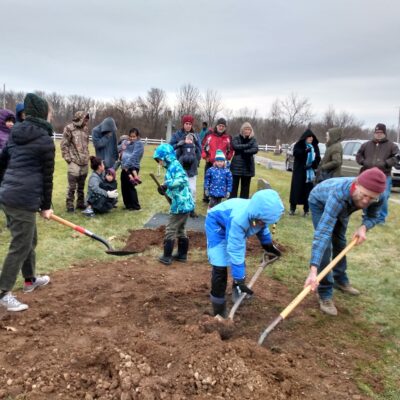We thank Janet Byler, Casandra Byler Stinson and Brenda Meyer, pastor of Benton Mennonite Church for sharing this personal and moving story with our network.
What is the best strategy if you wish to have a natural burial in a society that expects vaults, caskets and funeral home apparatus? Is it better to plan ahead–or assert the wishes of a grieving family in the moment?
Brenda Meyer, pastor at Benton Mennonite Church, Benton, Ind., had pondered this question but not resolved it when Urbane Byler, a member of her congregation, died from Parkinson’s disease on December 9, 2022. Urbane, his wife, Janet Byler, daughter Casandra and her three siblings had talked together about the details of dying and all were clear about Urbane’s wishes: He had hoped for a simple burial that would enable his body to return to the earth.
Before moving to Goshen, IN, the Bylers had farmed near Allentown, Pennsylvania, for many years. They worked with soil and were intimately connected with natural cycles. When livestock died, they buried them. Why couldn’t their own bodies be allowed to decompose in the same way?

Preparing to die
Photo caption, left: Janet Byler of Benton Mennonite Church, Benton, Ind., helps her family practice moving a body in preparation for a green burial. The quilt shown later served as the shroud when her husband, Urbane Byler was buried.
Janet and Urbane had prepared well for death. They discussed it openly with their children; they had been part of a Christian Education class at Benton that was working on end of life issues; and they had researched the topic. Janet and Urbane had also regularly attended a Death Cafe at Greencroft, the retirement home in Goshen, Indiana, where the couple lived. “Death Cafes” are events that bring people together to discuss the taboo topic of death over tea and cake. Their purpose is to educate people, reduce the fear of death and enable them to live more fully in the meantime.
In the Bylers’ case, a clear intention, a supportive pastor, and a little spontaneity resulted in a burial that expressed the family’s values and gave them a great deal of joy. It also kept steel, wood and a ton or two of concrete out of the ground.
On the night it was clear that Urbane was dying, the Bylers asked their pastor if a green burial would be possible. Brenda was sympathetic. She, too, wanted to simply be laid in the ground in a shroud when the time came. But would a cemetery and funeral home permit this? She didn’t know, but she advised the family to request that Urbane’s body not be embalmed. Bodies can be kept in cold storage for seven to ten days even without embalming.
No arguments needed
The next day, the Bylers and Brenda went to the Benton Lutheran Cemetery a half mile from their church with their best arguments in hand. They knew that the cemetery did not have regulations requiring vaults, but they had also been told that the closest cemetery allowing green burials was in Indianapolis, hours away. To their surprise, no arguments were needed.
“If that’s what he wanted, then that’s what we’ll do,” the young cemetery trustee said when he heard Urbane’s wishes.
With a cemetery in place, the Yoder-Culp Funeral Home, Goshen, Ind., was supportive and agreed to simply wrap the body for burial and transport it to the grave. They advised that the family think through the physics of moving a body themselves in order to avoid awkward mishaps.
The Bylers took this advice to heart and went to work on logistics. The transport solution they came up with involved 100% recycled materials: a leftover board to hold the body, sturdy muslin strips to raise and lower it and for a shroud–a handmade quilt that was worn but still colorful.
“It was beautiful; I get teary remembering it,” Casandra says. Another issue they needed to think through was what clothing would biodegrade, since garments often include polyester, zippers, buttons or other items that do not.
Pies and a quilt
Casandra and Janet cherish their memories of the “dress rehearsal” for the burial. Since Urbane’s death came near the end of a natural life span, it was possible to appreciate the experience without being overwhelmed by grief. A sixteen-year-old granddaughter baked pies for the occasion and her nine-year-old brother was involved in the process as well. Janet obliged as “the body.” They wrapped her in the quilt and practiced lifting her, in between pie and laughter.
The actual burial took place four days after Urbane died. One surprise was the fact that the grave had been dug six feet deep–while the family had been told that three to four feet was the proper depth for decomposition. They scrambled to fill in the grave to the right depth. After the pallbearers knelt and lowered Urbane’s remains into the ground, people of all ages took turns tucking the body into the earth. A pumpkin and apple were buried as well because the Bylers had grown these crops. Gentle shovelfuls from adults alternated with thunks of earth from energetic children.
After the burial, the Byler family held a gathering to acknowledge the death, since the memorial service was postponed to allow for long-distance travel. Friends who had not been to the grave were puzzled by the celebratory air at a time like this.
“We were so elated and so proud that we had pulled this off!” Casandra explains. “It was like wanting to tell and retell labor and delivery stories.”
Knowing Urbane as she had, knowing how much his commitment to earth keeping mattered to him, Brenda shares the family’s joy.
“Urbane and Janet have been trailblazers, willing to live out their beliefs even when they were unusual,” she concludes. With the help of a supportive community, cemetery and funeral home, Urbane’s death reflected his values, just as his life did.
